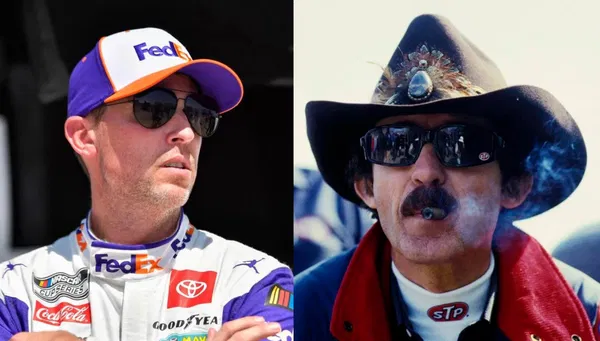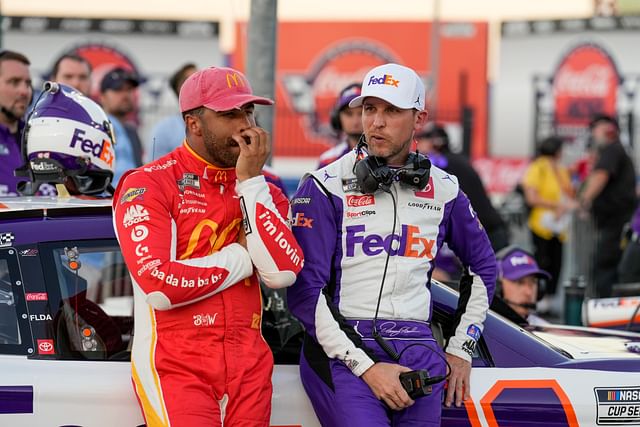Richard Petty, a legend in NASCAR, expressed his boredom after watching the recent race at Bristol Motor Speedway, stating that it was among the least exciting races he has witnessed. “Of all the races I’ve seen in a long time, Bristol was the least racing of any place we’ve ever seen,” he remarked following Kyle Larson’s commanding victory, in which he led 462 of the 500 laps. Fans had high expectations for the Bristol race, hoping it would echo the thrilling events of the season’s first race, but it fell flat.
During the spring race, teams struggled with excessive tire wear that exceeded both NASCAR’s and Goodyear’s predictions. Midway through that race, teams were granted additional attempts to complete their laps. Veteran driver Denny Hamlin emerged victorious, thanks in large part to JGR’s skillful tire management. In stark contrast, the latest Bristol race offered little excitement, turning into a monotonous display dominated by Larson. This lackluster performance has led NASCAR veterans to question the current short-track package, with even Richard Petty joining the chorus of critics.
The only adjustment NASCAR implemented for 2024 was the introduction of a new aerodynamic package, which included splitter stuffers, an increase in spoiler width from two inches to three, and a simplified diffuser with accompanying strakes. However, the horsepower remained unchanged at 670, which has become a point of contention. Denny Hamlin, who finished fourth in the recent race, has been vocal about his desire for increased horsepower, advocating for a return to the 750 horsepower used before the advent of the next-generation cars.
Hamlin articulated his thoughts on the issue, stating, “The more you can get us out of the gas, which means if we have more horsepower, we have to let off sooner, that gives us the opportunity to overtake the cars behind.” He believes that even a 50-horsepower increase would provide an advantage in passing, asserting that it would not require significant changes to the overall setup. However, NASCAR has been reluctant to make such changes, citing safety concerns as their primary reason.
Richard Petty, known as “The King” and a short-track racing icon, also weighed in on the horsepower debate, echoing Hamlin’s sentiments. Petty emphasized the need for more horsepower, especially on short tracks, explaining that when cars drop low on the track, they tend to bog down due to a lack of power. With 552 Cup Series starts on short tracks and 128 wins, Petty’s insights are grounded in substantial experience, making his comments about the recent Bristol race particularly noteworthy.
In the first Bristol race of the season, there were 54 lead changes, a stark contrast to the mere eight lead changes in the recent race. This decline in competitiveness was partly attributed to drivers opting to stay out for additional points during stage breaks, resulting in a lack of overtaking opportunities. Aside from Larson, only three other drivers managed to lead laps: Alex Bowman, who led 34 laps after starting in pole position, Tyler Reddick with three laps, and Bubba Wallace, who led for one lap. This pattern mirrors recent short-track races, such as Richmond, where only three drivers led a significant portion of the race.
Many observers attribute this trend to reduced tire wear, while NASCAR veterans largely point to the next-gen car as the culprit. Denny Hamlin insists that increasing horsepower is just the first step toward addressing the issues with these new vehicles. He has previously suggested a complete redesign of the next-gen car, stating that it should maintain its next-gen designation but require an overhaul across its entire structure, from the front to the rear. Hamlin reiterated these concerns following the recent Bristol race, highlighting NASCAR’s tendency to address car problems with tire solutions, rather than fixing the fundamental design issues.
Dale Earnhardt Jr. also chimed in, agreeing with Hamlin regarding the shortcomings of the next-gen car. He noted that the current design seems more suitable for road courses than oval tracks, which has led to a series of underwhelming races. “We bounce back and forth between where we put the blame every time we have one of these bad races,” Earnhardt said, acknowledging the difficulty in pinpointing the exact cause. He further noted that the next-gen car shares many technological components with road course supercars, which complicates its performance on oval tracks.
With the penultimate race of the season approaching at Martinsville, the urgency for NASCAR to implement changes is mounting. Should that race also turn out to be lackluster, it could spell disaster for the sport’s reputation. As fans and veterans alike call for reforms, the pressure is on NASCAR to deliver a more exciting racing experience that honors the sport’s rich tradition of competition and excitement. The discussions surrounding horsepower and car design are not just technical matters; they reflect the broader concerns about maintaining fan engagement and ensuring that NASCAR continues to thrive in a competitive entertainment landscape.
Bristol Boredom? Richard Petty & Denny Hamlin Urge NASCAR for More Power!




